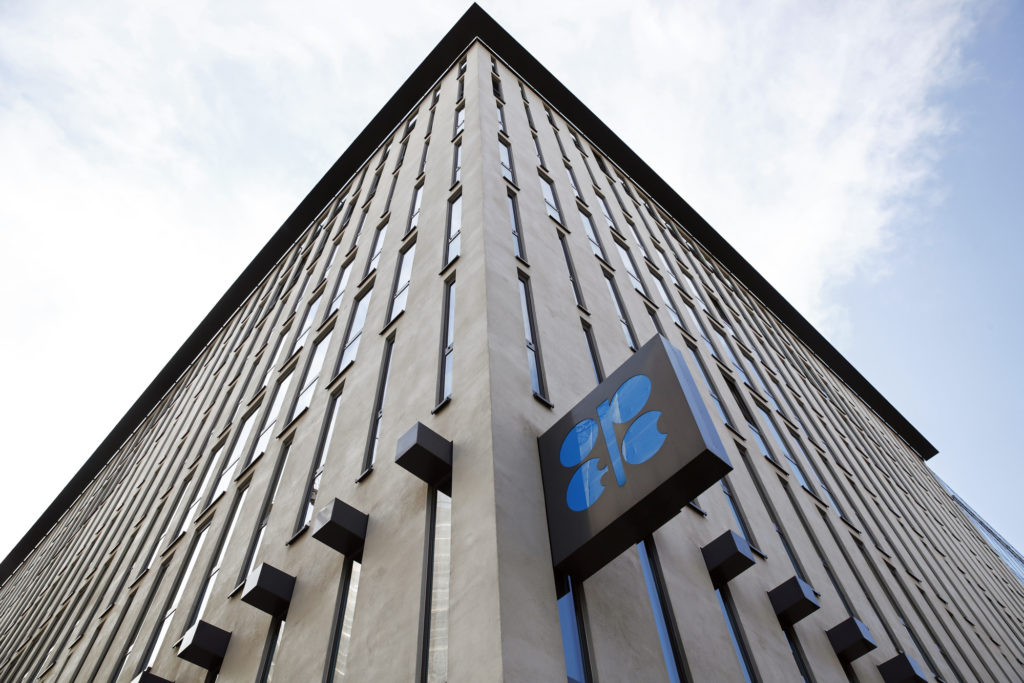
Russia’s oil minister returns to Vienna on Friday for a tense meeting with the country’s OPEC allies, as the cartel engages in a high-stakes diplomatic gamble that risks a price crash if it backfires.
OPEC ministers told Russia on Thursday that if it doesn’t join them in cutting oil output by another 1.5 million barrels a day to offset the impact of the coronavirus, then the cartel could abandon its reductions altogether. Hours later, the group raised pressure on Moscow again, emerging from an informal meeting at the Saudi delegation’s hotel with a proposal to extend the curbs for even longer than initially suggested.
After flying back to Moscow to consult with the Kremlin on Wednesday, Energy Minister Alexander Novak is due back in the Austrian capital on Friday morning for a new round of talks. Unless Moscow cuts output, “there will be no deal,” his Iranian counterpart Bijan Namdar Zanganeh said on Thursday.
Even as OPEC Secretary-General Mohammad Barkindo struck a conciliatory tone and praised Russia as a dependable ally, the oil market braced for more drama. Brent settled below $50 a barrel in London on Thursday evening for the first time in almost three years, after falling more than 20% since the beginning of the year. It tumbled further on Friday.
“Panic is worsening, demand forecasts are falling, this is a no-kidding emergency and they’ve got to get Russia to ‘Yes’,” Bob McNally, president of consultant Rapidan Energy Group, said in a Bloomberg Television interview. “If they commit an epic policy failure by not cutting production, I think we can easily see a revisitation of old lows, in and around $26.”
The standoff is the biggest crisis since Saudi Arabia, Russia and more than 20 other nations created the OPEC+ alliance in 2016. The group, controlling more than half of the world’s oil production, has underpinned prices and reshaped the geopolitics of the Middle East, but is now under significant strain. The risk for the Saudis is that if their gamble to corner Russia into a production cut backfires, they have more to lose as they need higher oil prices to fund their budget than Russia does.
“None of them can afford a price collapse,” said Roger Diwan, a veteran OPEC watcher at consultant IHS Markit Ltd. “This is a battle of egos against reality.”
The current version of the OPEC proposal calls for the cartel to cut 1 million barrels a day of its production, contingent on non-OPEC nations led by Russia reducing their output by 500,000 barrels a day. Ministers initially proposed the curbs for just three months, from April to June, but hours later, in a rare move even by the chaotic standards of OPEC meetings, the group reworked its plan and suggested the cuts stay in place until the end of the year.
Only in July, Russia and Saudi Arabia touted their alliance as a marriage to “eternity”. Fast forward less than a year, and the view among traders is that the couple may be on the verge of divorce. Still, it’s not the first fight between Moscow and Riyadh, and both sides have been able to find a satisfactory solution in the past.
The Kremlin has gained a lot from its cooperation with OPEC. The country has been the biggest financial beneficiary of the cuts, largely because it’s borne a lesser share than Saudi Arabia. The alliance has also significantly enhanced President Vladimir Putin’s presence on the world stage and his political clout in the Middle East.
Following the collapse in oil prices this year as the economic impact of the coronavirus saps demand, the risks for the Friday meeting between OPEC and Russia are high. Not just for their alliance, but for the entire energy industry, from Exxon Mobil Corp. to smaller shale drillers in Texas, and oil-rich nations in Africa and Latin America.
The stakes in this game of diplomatic poker are huge — 1.5 million barrels a day of fresh oil cuts, plus 2.1 million of existing curbs OPEC+ agreed on last year that expire at the end of this month. That’s equivalent to the consumption of Germany and France combined.
“OPEC is making the cuts conditional on Russia joining,” said Amrita Sen, chief oil analyst at consultant Energy Aspects Ltd. “Saudi Arabia may be ready to walk away if it doesn’t get a positive answer.”
So far, Russia has indicated it’s only prepared to roll over the current cuts for another three months, and doesn’t want to go deeper. Moscow appears to be betting that the oil market would re-balance by itself over the next few months as low prices take their toll.
In particular, Russia believes that the U.S. shale industry is about to go in reverse. Exxon on Thursday announced it was slowing the pace of its flagship project in the Permian Basin.
Goldman Sachs Group Inc. earlier this week became the first major Wall Street Bank to forecast a contraction in consumption this year, suggesting that an even large cut may not arrest the drop in oil prices.
“Cutting production, 1.5 million barrels a day in April or May, is not really going to save you in the current environment,” said Jeffrey Currie, global head of commodities research at Goldman. “The demand damage is happening today, right now.”
Oil is now trading far too low to balance the budgets of most OPEC members. Riyadh needs more than $80 a barrel, according to the International Monetary Fund. Russia only requires a price of about $40 a barrel to balance its budget. Brent was at $49.11 at 8:16 a.m. in London on Friday.